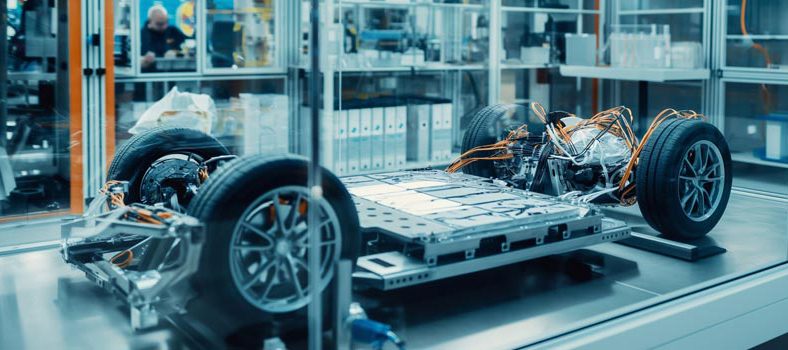Topping the list of EV inhibitors are cost and consumer perception of long-term reliability of the vehicle. After batteries, power electronics contribute the greatest cost to EVs, when compared to a traditional internal combustion engine (ICE) vehicle. Additionally, inverters and converters are among the most stressed powertrain components.
Increasing inverter performance, reliability, and lifetime – while reducing size and cost – are critical requirements for the success of EV adoption.
Insulated Gate Bipolar Transistor (IGBT) modules are at the heart of the EV power inverter. IGBTs manipulate the power delivered to the motor by literally switching the battery pack voltage on and off at high rates of speed. They make up the majority of the inverter cost.
IGBTs generate a lot of heat during switching, and it is imperative to keep them cool. A typical configuration for IGBT thermal control is indirect-liquid cooling. In this configuration the IGBT module heat sink is pasted to a liquid cooling circuit using thermal grease. The liquid is a standard 50/50 mixture of water and automotive antifreeze. This configuration has proven more effective than air-cooling in an EV application, but it can be improved further with recent IGBT packaging advancements.
Hatchi Power Devices now offers a line of IGBTs that use a direct-liquid cooled configuration. The base of these IGBT modules is a pinned heat sink that makes direct contact with the liquid coolant.
The company claims this configuration improves cooling performance, eliminates manufacturing steps, improves reliability, extends inverter lifetime, and lowers overall system cost. Hitachi’s Jeff Knapp walked us through the major advantages of their cooling technique.

When compared to indirect-liquid cooling, direct-liquid cooling eliminates non-thermally conductive layers between the IGBT die and the heat sink. This leads to lower thermal impedance with a 35% improvement in cooling performance, and results in greater inverter efficiency.
Direct-liquid cooled IGBT modules experience lower temperatures at critical solder points. This means lower stress at the same levels of operation, resulting in reduced thermal fatigue on the IGBT modules and longer life of the inverter – especially critical in urban environments with repeated stop-and-go traffic situations.
Application of thermal grease in the indirect-liquid cooled inverter is a critical step that requires inspection and is prone to failure. By eliminating the thermal grease layer in the direct-liquid cooled design, inverter assembly is made faster, easier, and more reliable.
Although still relatively new, inverters using direct-liquid-cooled IGBT modules are presently available on the market.
Mr. Knapp tells us that thousands of IGBT modules operating in the field confirm the reliability studies.
Cat-like reflexes
Canadian firm TM4, spun off by Hydro-Quebec in 1998, recently released details of its new Reflex™ gate driver technology.
Company representatives tell us that inverters equipped with this new tech will have optimized use of the IGTBs – reducing commutation losses and maximizing the amount of current that can be sent to the motor.

“The big cost driver in automotive is current, if you can get more current out of the same component, it is directly proportional to cost. We are able to use the same IGBT modules as most companies, while getting 30-40% more current out of that IGBT,” said Eric Azeroual, TM4’s director of sales & marketing.
“[This is] probably the most dense inverter in the world at the moment, a patent-pending technology. ReflexTM anticipates a voltage peak on the IGBT, and it ensures that it never reaches the voltage limit: 650 volts in our case. It’s a combination of hardware and software. TM4 uses INFINEON® HybridPACK™2, but designs and manufactures their own gate drivers. Most people using the same module limit the current to 450 amps, while we limit the current to 650 amps.”
The company is currently testing the new design in real-world prototype trials.

Thermal grease
Thermal grease (also known as thermal compound or heat sink compound) is a substance commonly used in electronics to increase the thermal dissipation from a heat-generating component to a heat sink.
Generally, the grease has a thermal conductivity between 0.5 and 10 W/mK, far less than metal heat sinks, which have between 220 and 420 W/mK. However, the grease is meant to fill the microscopic air gaps and grooves that exist between a component and a heat sink. The thermal conductivity of the air, 0.034 W/mK, is far less than that of the grease.
Indirect-liquid cooling requires a thermal grease to be applied between the IGBT baseplate and the heat sink. Any variation in thermal grease thickness causes temperature non-uniformities. While under operation, the IGBT module experiences temperature changes and produces transformations, because it is comprised of materials with different thermal expansion coefficients. This leads to warpage of the IGBT base plate, and, over time, causes thermal grease movement, further thermal impedance variation, and eventual failure of the inverter. By contrast, the direct-liquid cooled approach does not require the thermal grease layer and virtually eliminates the risk of thermal impedance variation.

Pushing IGBTs to the limit
Passive technique
One common technique to maximize voltage and current ratings of an IGBT is soft switching two-level turn off. This passive feature is embedded in some gate drive chips, like ST Microelectronics’ TD350E, and works by minimizing the overshoot (but not the stray inductance, which is relative to the layout of the IGBT module and the gate driver). The idea is to reduce the gate voltage when a desaturation event occurs, before turning it off completely to prevent extreme overshoots from occurring. However, this method increases losses and makes the thermal design more challenging.
TM4’s active technique
TM4’s unique new feature is an active mechanism that uses the stray inductance of the IGBT to control the current during the turn-off process, without slowing down the rate of voltage change. It doesn’t trigger when desaturation occurs, but only during the maximal overshoot period, and the company says it has virtually no negative effect on efficiency and temperature during normal operation.























































































